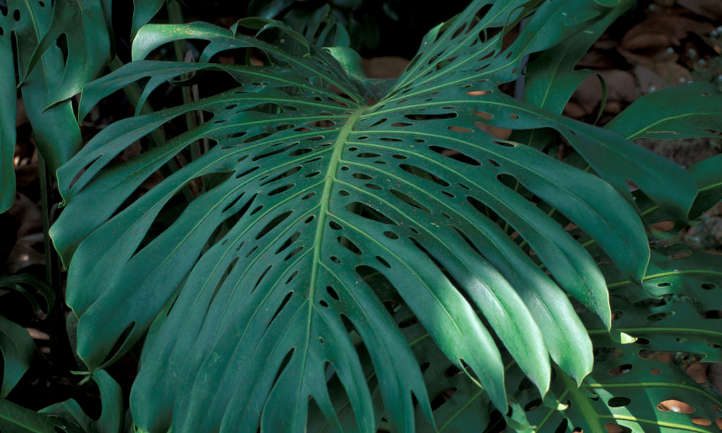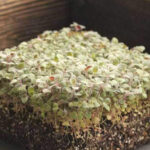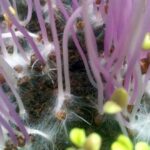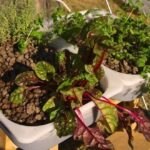Do you like to make your indoor space look like a veritable jungle? If so, you’ll need to grow Monstera deliciosa. This giant-leaved climbing plant can really liven up your living room.
Indoor specimens often grow to 4-5 feet in height. Those which grow in their native rainforest environments can often get to ten feet or more!
These plants themselves aren’t edible, and in fact they’re poisonous. But they produce a fruit called the monster fruit, which is edible when ripe. Don’t bite into an unripe green fruits, though! These fruits are full of calcium oxalate crystals when unripe and can irritate your throat!
With a scientific name that literally means “delicious monster,” you can’t go wrong. This unusual plant will bring lots of tropical color to your living space!
Subscribe to the Epic Gardening Podcast on
Monstera Deliciosa Overview

| Common Name | Monstera deliciosa, delicious monster, monstera plant, monster plant, monster fruit, monsterio delicio, monstereo, hurricane plant, fruit salad plant, fruit salad tree, Swiss cheese plant, cheese plant, Mexican breadfruit, Penglai banana, ceriman, windowleaf, balazo, split leaf philodendron, and other localized names |
| Scientific Name | Monstera deliciosa |
| Family | Araceae |
| Light | Bright, indirect sunlight. Avoid direct sun. |
| Water | Keep soil moist but do not overwater |
| Humidity | Rainforest plant, requires high humidity |
| Soil | Loamy, well-draining soil |
| Fertilizer | Regular applications of diluted liquid fertilizer or organic granular fertilizer |
| Pests | Spider mites & scale insects/mealybugs |
| Diseases | Not subject to most plant diseases, but can develop root rot if excessively watered |
All About Monstera Deliciosa
Tons of common names exist for this plant. Fruit salad plant or fruit salad tree, Swiss cheese plant, monstereo… there’s just bunches of different names. It’s been referred to as the Mexican breadfruit because it can rarely produce a fruit. Another species, Monstera adansonii is sometimes called the Swiss cheese plant.
In the southeastern USA, it’s often called hurricane plant. The green ear-shaped leaves of this plant may be broad, but they’re filled with many naturally-forming holes. This also gives it the Swiss cheese plant name!
Originating in southern Mexico and down into Central America and South America, it’s definitely tropical. Its natural habitats are rainforests, and it is an epiphyte. While it does have soil-based roots, it also has roots along the stem. These aerial roots grab onto tree bark and allow it to climb upwards.
All portions of the split leaf philodendron are poisonous at some point. The leaves, stems, sap, and even the roots are never safe to eat. In the right habitat, the plant can flower, producing an unusual spiky growth.
While the flower spike is also inedible at first, it ripens over time into a very uncommon and edible fruit. These rarely produce flowers outside of their natural habitat. Greenhouse conditions can mimic their habitat more accurately.
Monster fruit is safe to eat unless you have a sensitivity to calcium oxalate crystals, but only when ripe. Unripe fruit can cause irritation of the mouth and throat. I’ll tell you how to determine ripeness in a bit!
The plant isn’t grown for its fruit nor its weird, spiky flower that forms its fruit. Instead, it’s grown for those dramatic leaves. In container conditions, the leaves usually are 1-2 feet in length. Natural habitat growth can see those leaves reaching up to 3 feet long.
There are even variegated cultivars with monstera leaves that are striped and flecked with white and cream. A mature plant area with the multicolored leaves of variegated monsteras is certainly a striking view inside the home. Do not confuse these deliciosa species with Monstera variegata, though. There is question about the edible nature of Monstera variegata fruit. The same goes for other variegated monsteras.
In short, this delicious monster is only delicious when it’s ready to be. But it’s visually stunning year-round!
Caring For Monstera Deliciosa

Outside of its natural tropical habitat, monstera plants are less hardy. They require warm temperatures and humidity to really thrive. Here’s some hints on the best conditions you can house your plant in.
Light and Temperature
Your monstera plant loves bright, indirect light. Too much direct sunlight will cause it to burn, and it takes surprisingly little! Remember, it prefers the forest floor in Central America, and South America.
Because of this, it’s best to grow your Swiss cheese plant in either partial or full shade. Be sure it has plenty of ambient lighting, but avoid the sun’s full touch whenever possible.
Temperature-wise, the perfect range for this tropical from warm climates is 68-86 degrees. If the temperature dips below 50 degrees Fahrenheit, growth will stop. In frost conditions, your plant will die off, so avoid cold weather entirely!
It’s best to only grow this plant outdoors if you’re in USDA zones 10-11 as they have the right temperature range. When grown outdoors, your plant can potentially reach heights of 10′ tall if it has proper support. This seldom happens indoors.
People in other zones should opt to maintain their plant as an indoor plant only. Provide the right temperature range and ample humidity for your jungle plant!
Water and Humidity
Too much water, and your monstera is susceptible to rot issues. But too little, and it may wilt. Let’s go over the best way to water and provide the right humidity for your plant.
When the soil is dry to about 2″ below the surface, it’s time to water. Provide water at the base of the plant. Fill the pot completely full, then allow the excess water to drain out. Repeat this 2-3 times to be sure the soil has absorbed enough water.
Once the plant has drained its final time, pour off any excess standing liquid in the plant’s tray. If you’re not using a tray, you can skip this step.
In the winter, slow down your watering frequency. Wait until 3-4″ of the soil is dry, but don’t allow the plant to wilt. Monstera requires much less water during the winter months.
Humidity-wise, high humidity is preferable. However, your plant can tolerate drier conditions occasionally.
To maintain the humidity around your plant, you can mist it. Misting should be twice per week and should be done in the morning hours so excess water can dry. Use filtered water or distilled water to do this.
There’s an extra step with monstera, too. Cleaning your plant’s leaves may be required, especially if it’s indoors. Place 2-3 drops of dish soap into a bowl of water. Dip a clean cloth into the water and wring out excess, and then use that to wipe down the leaves. A monthly cleaning will reduce dust buildup on the leaves and keep pest issues at bay.
Soil
Monstera will tolerate slightly-sandy soils, but prefers a peaty, well-draining soil. Your soil should be nutrient-rich and should hold moisture without getting soggy.
I like to use a standard potting mix with extra sphagnum moss worked into it. This works surprisingly well. If your potting mix doesn’t have perlite in it, adding a little perlite will improve drainage.
Fertilizer
There’s a couple ways which you can fertilize your monstera plants.
The first, and most popular, is to find a liquid 20-20-20 fertilizer. Use about a half-teaspoon of that diluted in a gallon of water. Apply that directly to the soil to replace a routine watering session. Be sure to pour out any excess liquid in the plant’s tray when you’re done.
A slow-release granular fertilizer can also be used for Swiss cheese plants. Find one which is a balanced NPK with a good level of magnesium in it. It’s preferable to use one with organic nitrogen sources as those are more easily used by the plant.
If using the granular, apply 1/4lb every 8 weeks throughout the plant’s first year of growth. Do not fertilize in the winter. In subsequent years, gradually increase the fertilizer to 1lb. Reduce the frequency of fertilizing to 2-3 times during the growing season.
Monstera deliciosa which is grown in sandy soil with a low pH should also get an annual soil drench. This should be done in the early summer, June being optimal. Use a mix of chelated iron and water to provide the necessary iron boost your plants will need.
Propagation
Monstera deliciosa can be propagated from seed, cuttings, division or air layering.
By seed can be difficult, as seeds are hard to find and aren’t present on young plants. Since this plant produces fruit and the seed has a short shelf life, it’s important to plant it fast. Use a thin coating of soil overtop and keep it moist until it germinates in a few weeks. Plants grown from seed will take a long time to develop into larger plants.
Cuttings should be taken of fresh, healthy leaves which have aerial roots attached. Cut with clean pruning shears below a leaf node, taking care that your cutting has those roots. You can place your cutting into water or into prepared potting soil. Rooting hormones are not necessary, as monstera rapidly develops new roots.
Division isn’t possible on young plants, but it’s a good choice for older plants. Cut some of the suckers into foot-long segments and gently press them into the soil. New roots will develop and your plant will begin to grow.
Finally, there’s a technique called air layering. Moisten some sphagnum moss, wringing out excess water. Wrap it around the joint where an aerial root and leaf axil are located.
Once in place, tie the moss with string to keep it there, and wrap with plastic (either plastic wrap or a plastic bag). Be sure to leave air vents in the bag or poke some holes to allow for air to penetrate. New roots should form within a few months, and you can clip it off below the roots to replant elsewhere.
Repotting
Monstera deliciosa should be transplanted in fresh soil about every two years. If it’s growing faster, transplant it when it’s outgrown its existing pot. Aim for a pot which is 2″ wider than the prior one, as that provides plenty of space.
Be sure that your pot has plenty of drainage holes and is deep enough to support a large stake or trellis. As this plant is a natural climber, you’ll want something for it to crawl up!
Fill the bottom third of your pot with a prepared soil blend. Carefully unpot your monster plant and set it into place. Fill to the height at which it was previously planted, tucking in any aerial roots.
Once it’s in place, tamp down the soil around the plant to secure it in place, adding more soil if necessary. Place a heavy stake or trellis in place, being sure it’s secure. You can then use plastic ties or strips of cloth to tie the plant stem to the support.
After repotting, provide a good deep watering for your plant to be sure the soil is holding moisture. You can then resume normal watering and fertilizing cycles.
It’s easiest to transplant your monstera deliciosa during or at the end of the winter months. This is when the plant’s not developing much new growth, and it will reinvigorate come spring.
Training & Pruning
A climber by nature, monstera deliciosa can easily reach ten feet tall in its original locale. Its aerial rootlets will latch onto tree bark with tentacle-like precision. Unlike most other climbing plants, these rootlets do no damage. They only work to hold the plant aloft.
Because of this, indoor growers will likely want to provide some form of support. This can be a wooden stake or board, or it can be a wooden trellis. Wood or other natural materials are best as they’re easiest for the plant to grip onto.
Be sure that your support is well anchored in its place. While the plant doesn’t get top heavy, the large leaves do have some weight.
Pruning is mostly cosmetic or to retard further growth. Lower leaves which are dying off can be removed by cutting 1/4″ above the stem joint. This allows you to remove the leaf in its entirety without harming the plant’s base.
Aerial roots that become unruly are easy to snip off with a clean and sterile pair of pruning shears. If they’re close to the soil, you can tuck the rootlets into the pot instead of clipping them off.
Excess growth in places you don’t want it can also be removed as needed. Be sure not to take too many leaves off at once as the plant still needs some, and avoid cutting the main stalk.
Monstera Deliciosa Fruit: How To Eat It Safely
The fruit of monstera deliciosa is sometimes called the tropical salad fruit. And there’s good reason for that name, as it’s reputed to taste like a blend of pineapple, mango, and banana!
But if they are unripe green fruits, they are full of oxalic acid which will burn your mouth and throat. Unripe fruit can also be flecked with little black specks of concentrated acids. How do you know when to harvest?
First, the fruit will form on the plant in the form of a spathe and spadix. The spathe is a large leaflike flower that surrounds the spadix, or eventual fruit. The spadix develops what appear to be greenish scales around the fruit.
As the lower part of the scales begins to yellow, your fruit is starting to ripen, but it’s not ready yet. Wait until the scales at the bottom of the fruit begin to peel back, exposing the corn-like fruit underneath.
Once the scales start to peel back, cut the fruit free of the stem and place it in a paper bag to allow it to get fully ripe. As the scales come off, you can eat the exposed portion of the fruit, picking off any black flecks you see. Discard these flecks. They’re leftover calcium oxalate and can be an irritant.
Don’t exert any pressure on the scales to try to peel them back further. The starches in the fruit need time to convert to sugars, and so it will get fully ripe very slowly. Only the parts that the scales have flaked off of are safe to eat.
This fruit can be eaten when ripe, or can be made into an exotic jam. Those who are sensitive to oxalic acids or oxalates will still want to avoid it. But if you’re not sensitive, enjoy your rare rainforest treat!
Here’s a short video of the ripening process and a description of the fruit’s flavor.
Monstera Deliciosa Problems
Free of the majority of pest or disease issues, the monstera deliciosa plant can be a fun plant to grow. But there are a couple hints I can offer for an assortment of odd issues that could arise.
Growing Problems
Sometimes even with the best care, monstera plants can have a few issues. Let’s go over what to do if any of these arise.
If you see yellowing leaves, this is generally a symptom of too much direct sunlight. While the gigantic showy leaves seem impervious, they’re easily burned by the rays of the sun. The Monstera deliciosa plant likes bright light, but it should be indirect!
Yet too much shade isn’t good either. Hurricane plants don’t develop those big perforations in their leaves in low-light conditions.
Additionally, your monstera is prone to negative phototropism. When it’s in its natural habitat, a patch of darkness is usually a sign of a large tree or other plant nearby. Since they like to climb, your plant may actually start growing towards darkness. It’s looking for more light! Providing better lighting will stop that.
If your leaves are looking dried out, the plant’s not getting enough water. You should increase your watering frequency.
And finally, browning leaf edges are usually another sign of a lack of moisture or humidity. Mist your plant more frequently if leaf edges look a bit crisp.
Pests
Very few pests seem interested in this plant. But there’s two which are common on both indoor plants and outdoor plants.
Spider mites can cause small specks or patches to develop on leaf surfaces. These tiny mites suck the moisture out of the leaves and can result in yellow leaves if left unchecked. Combat them by giving all leaf surfaces a good misting of neem oil. The naturally-forming azdirachtin will kill off mite eggs and slowly poison adults.
Scale insects, particularly mealybugs, are also prone to appearing. These attach themselves to leaves and stems, sucking the vigor out of your plant over time. Insecticidal soaps such as Safer Soap work well to eliminate these pests. Neem oil is an excellent preventative.
Diseases
This monstera is astonishingly resistant to most forms of plant diseases. When healthy and vigorous, very little will harm them!
Excessive watering can cause the roots to develop some root rot if you’re not careful. Damaged roots should get pruned off during your regular repotting. Avoid standing water in your pots, and make sure your soil drains well to prevent this issue.
Otherwise, your monstera should be disease-free!
Frequently Asked Questions
Q: Are there other uses for monstera deliciosa?
A: The long tendril-like aerial roots are traditionally used for ropemaking in Peru. They’re also worked into baskets in portions of southern Mexico.
Generally considered poisonous, they’re also used in some traditional herbal medicines. If you’re curious about how they’re used, consult a skilled herbalist. Don’t risk it on your own as they can be dangerous!
Q: Is Monstera deliciosa a good indoor plant?
A: The Swiss cheese plant is perfect as an indoor plant, mostly due to its tropical origins.
Q: What is the difference between a Monstera and a Monstera deliciosa?
A: The Swiss cheese plant is a member of the arum family, which produce spadix flowers. Monstera is part of this family and is in the genus Monstera, but doesn’t produce edible fruit like the Swiss cheese plant.
Q: How do you care for a Monstera deliciosa plant?
A: This entire piece covers that topic. Check it out!
Q: Does Monstera like sun or shade?
A: The Swiss cheese plant does best in bright, indirect light.
Q: How often should I water Monstera deliciosa?
A: Water your Swiss cheese plant every 1 to 2 weeks, keeping the soil moist.
Q: Are Monsteras good for beginners?
A: They are great plants for beginners.
Q: Why is my Monstera deliciosa not splitting?
A: Any aberration like this is a sign that you need to adjust the basic care for your plant. Make sure you’re giving it enough light and water, and providing proper nutrition.
Ready to grow your own monsterio fruit? Desperate for the large leaves of the plant? Hopefully you’re better prepared for growing this gargantuan tropical!









